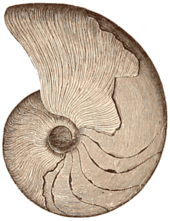Shimanskya
| Shimanskya | |
|---|---|
| Scientific classification | |
| Kingdom: | Animalia |
| Phylum: | Mollusca |
| Class: | Cephalopoda |
| Order: | Spirulida (?) |
| Family: | †Shimanskyidae Doguzhaeva, Mapes & Mutvei, 1999 |
| Genus: | †Shimanskya Doguzhaeva, Mapes & Mutvei, 1999 |
| Species: | †S. postremus |
| Binomial name | |
| Shimanskya postremus (Miller, 1930) | |
| Synonyms | |
| |
Shimanskya is a late Carboniferous fossil tentatively interpreted as an early spirulid.[1]
This identification was based on:
the well-developed phragmocone [which] possesses comparatively long camerae and [a] comparatively wide marginal siphuncle, the [absence of the] rostrum (at adult stages at least), and the [construction of the] shell wall, which is as thin as septa, has no nacreous layer and is subdivided into the inner and outer plates
— Doguzhaeva et al. 1999[2]
Doguzhaeva et al. also identify these features in living Spirula, and the fossil 'Spirulida' Naefia, Groenlandibelus and Adygeya -- though see these respective articles for discussion as to whether or not these extinct genera are themselves Spiruliids.
Some authors are happy to accept this designation.[3][4]
But others have argued that none of the characters observed in Shimanskya is clearly diagnostic of the Spirulids.[5]
For example, a nacreous layer may have been lost more than once in cephalopod evolution.[6]
Others view the microstructural evidence as ambiguous.[7]
Interpreting Shimanskya as a spirulid creates a large gap in the fossil record of the lineage.[8] Moreover, some molecular clock results predict that spirulids evolved much later than the Carboniferous, leading some to suggest that Shimanskya ought to be assigned to the coleoid stem group.[9][10] Other clock analyses, however, are consistent with its position in the spirulid lineage.[11]
References
- ↑ Strugnell, J.; Jackson, J.; Drummond, A. J.; Cooper, A. (2006). "Divergence time estimates for major cephalopod groups: evidence from multiple genes". Cladistics. 22: 89–96. doi:10.1111/j.1096-0031.2006.00086.x.
- ↑ Doguzhaeva, L. A., Mapes, R. H., & Mutvei, H. (1999). A Late Carboniferous spirulid coleoid from the southern mid-continent (USA): shell wall ultrastructure and evolutionary implications. In F. Olóriz & F. J. Rodríguez-Tovar (Eds.), Advancing Research on Living and Fossil Cephalopods (pp. 47–57). New York: Kluwer Academic Publishers.
- ↑ Kröger, B. (2003). The size of the siphuncle in cephalopod evolution. Senckenbergiana Lethaea, 83, 39–52.
- ↑ Warnke, K., & Keupp, H. (2005). ~Spirula~—A window to the embryonic development of ammonoids? Morphological and molecular indications for a palaeontological hypothesis. Facies, 51(1–4), 60–65. doi:10.1007/s10347-005-0054-9
- ↑ Warnke, K; Plötner, J; Santana, JI; Rueda, MJ; Llinas, O (2003). "Reflections on the phylogenetic position of Spirula (Cephalopoda): preliminary evidence from the 18S ribosomal RNA gene" (PDF). Berliner Paläobiologische Abhandlungen. 3: 253–260.
- ↑ Strugnell, J., Jackson, J., Drummond, A. J., & Cooper, A. (2006). Divergence time estimates for major cephalopod groups: evidence from multiple genes. Cladistics, 22(1), 89–96. doi:10.1111/j.1096-0031.2006.00086.x
- ↑ Hewitt, R. A., & Jagt, J. W. M. (1999). Maastrichtian Ceratisepia and Mesozoic cuttlebone homeomorphs. Acta Palaeontologica Polonica, 44(3), 305–326.
- ↑ Hewitt, R. A., & Jagt, J. W. M. (1999). Maastrichtian Ceratisepia and Mesozoic cuttlebone homeomorphs. Acta Palaeontologica Polonica, 44(3), 305–326.
- ↑ Warnke, K. M., Meyer, A., Ebner, B., & Lieb, B. (2011). Assessing divergence time of Spirulida and Sepiida (Cephalopoda) based on hemocyanin sequences. Molecular Phylogenetics and Evolution, 58(2), 390–394. doi:10.1016/j.ympev.2010.11.024
- ↑ Kröger, B., Vinther, J., & Fuchs, D. (2011). Cephalopod origin and evolution: a congruent picture emerging from fossils, development and molecules. BioEssays, 33(8), 602–613. doi:10.1002/bies.201100001
- ↑ Strugnell, J., Jackson, J., Drummond, A. J., & Cooper, A. (2006). Divergence time estimates for major cephalopod groups: evidence from multiple genes. Cladistics, 22(1), 89–96. doi:10.1111/j.1096-0031.2006.00086.x
